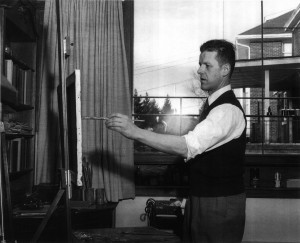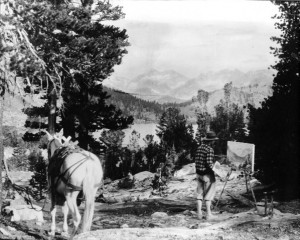
Eugene Kingman was born in Rhode Island in 1909. Throughout his early childhood and formative years in Providence, he showed an immense interest in art, science and nature, while constantly pursuing drawing and painting as a hobby. Later Eugene studied at Yale University, where he received two degrees (Geology in 1932, and Fine Arts in1935). While a student there, he achieved national attention with a commission from the National Park Service to paint scenes of major parks seven of which were displayed at the Paris Expo in 1931. Four of these paintings (Yellowstone, Grand Teton, Crater Lake and Sequoia) are still housed in the Department of Interior in Washington, D.C, while the three other paintings (the Grand Canyon, Mt. Rainier and Yosemite) are maintained in vaults inside other national parks.
Eugene made a name for himself as one of the Regionalist American artists. During the New Deal era in the 1930s he was awarded another major commission to create spectacular murals in three US post offices in East Providence, RI, Hyattsville, MD, and Kemmerer, WY, which are still on display today.


Also, during that decade, Eugene continued to be very drawn to nature’s wonders in various national parks. In fact, he was invited to use his combined scientific and artistic background to illustrate an article, featuring thirteen landscape paintings of Crater Lake and Yosemite National Parks, which was published in the March 1937 issue of The National Geographic Magazine. As a “plein air” artist, of course he always had his paintbrushes and pallet handy to capture the stunning scenery, wherever he was at the time.
Soon after earning his Fine Arts degree at Yale, this young gifted artist taught lithography and mural painting at the Rhode Island School of Design for three years. In 1939 Eugene married his sweetheart, Elizabeth Yelm Kingman, who had been an anthropologist and park ranger at Mesa Verde National Park. He later became the father of two daughters: Mixie Kingman Eddy and Elizabeth Anne Kingman, and also the grandfather of Quinlan Kingman Eddy.
Following his marriage in 1939, Eugene and his wife moved to Tulsa, Oklahoma, where he became Director of the Philbrook Art Museum. After spending several years there, Kingman joined the Army in 1942 to serve as a cartographer for the Office of Strategic Services (OSS) in Washington, D.C. during World War II.
After the war ended, Eugene was hired in 1946 to become the Director of the Joslyn Art Museum in Omaha, Nebraska, where he served for twenty two years. During his career in Omaha, he developed his creative talents even more to become a pioneer in various exhibit design projects. In fact, he was invited to consult, plus design exhibits, such as ones at the Smithsonian and at several dams, sponsored by the U.S. Corps of Engineers in the Midwest. Moreover, for the first issue of American Heritage Magazine in 1954, he was asked to write about the Midwest and the painters who had been influenced by the Plains.
While working at the Joslyn Art Museum, another one of Eugene’s most noteworthy commissions happened in 1946, when he was invited by Mr. Arthur Sultzberger, Sr., CEO of the New York Times newspaper, to paint a large mural, which was displayed in the former New York Times building for many years. Using his own skills with maps and murals and consulting with a cartographer, Kingman painted a vast and accurate view of the Earth, a challenge since no one in the mid-1940s had ever seen what the earth looked like from space. He added a number of red dots on the map to mark major cities, such as New York, Paris, Tokyo and his then beloved home, Omaha. The mural was installed in the lobby of the New York Times Building in 1948, and for the next forty years it inspired generations of Times employees and visitors passing through the lobby. Then in the late 1980s the New York Times took down the mural during a lobby renovation and later donated it to the Joslyn Castle Trust in Omaha. When this mural arrived in May 2014, it was restored and displayed during a special unveiling ceremony at Omaha’s Public Library. At the publisher’s request, Kingman added the lines of poetry, which remain timeless and uplifting: “Every day is a fresh beginning — Every morn is the world made new.”
Later on Eugene moved to Lubbock, Texas to became an Interim Director and Special Exhibit Design Consultant at Texas Tech University’s Museum. He passed away in 1975.
Finally, it should be mentioned that during Eugene’s time in Omaha, his efforts to promote the arts in Nebraska and elsewhere earned him numerous civic awards, and other recognitions, including an Honorary Doctorate from Creighton University. Many folks in Omaha recognized his immense artistic talent and commissioned him to do a number of paintings. These were exhibited in several of Joslyn Art Museum’s galleries as a special memorial tribute to him, following his death in 1975. Thus, Eugene’s paintings currently are displayed on many walls throughout the United States in various museums and in a number of living rooms, including the Nebraska Governor’s Mansion. They were acquired as prized possessions, and continue to be treasured by many.